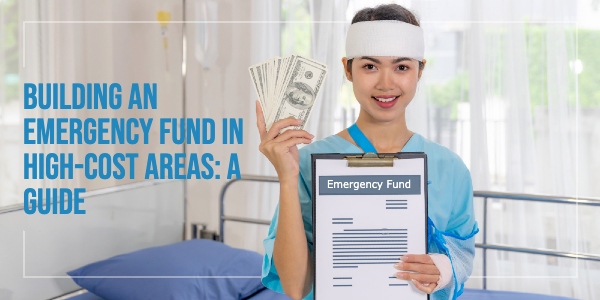Life is replete with challenges and surprises. While some events can be anticipated, others come unexpectedly and can severely impact one's financial stability. This is especially true in high-cost-of-living areas where the ripple effects of elevated expenses, from housing and utilities to groceries and childcare, can be overwhelming.
Understanding the Depth of Challenges in High-Cost Areas
Living in such an area is more than just higher rent or pricier transportation. There's often a cascading effect of expenses. Consider Lucy, a single mother in San Francisco. Despite earning above the national average, half her income was dedicated to rent. This left her vulnerable to even minor financial disruptions.
Building a robust financial emergency fund is crucial for navigating these challenges. In these areas, necessities like housing, transportation, and healthcare are often associated with hefty price tags. Individuals are more vulnerable to financial shocks like sudden job loss or medical emergencies.
An emergency fund offers a strong financial cushion against these unpredictable expenses, preventing the reliance on high-interest credit cards or loans, which can deepen financial stress.
What is an Emergency Fund?
An emergency fund is money held in a bank account designated explicitly for unforeseen expenses like medical bills, car repairs, or home maintenance. It is a financial cushion that can help you navigate income disruptions resulting from job loss or extended illness.
Having dedicated funds for unexpected bills minimizes the dependence on high-interest credit cards or personal loans, saving you from associated costs.
How Big Should Your Emergency Fund Be?
While many financial experts advise saving 3-6 months' worth of expenses, those in high-cost areas or unstable job situations might consider saving up to a year's expenses. The size should be evaluated based on individual circumstances and periodically reviewed, especially in response to life changes or inflation.
Building an Emergency Fund:
Determine Your Financial Standings
Start by understanding your monthly take-home pay. Review spending patterns over the past few months by examining your credit and debit card statements. Identify and eliminate unnecessary expenses, such as unused subscriptions. Christine Spiak, a Money Coach, recommends regular reviews for better financial clarity.
Set Your Savings Goal
Michael Charalambous, Director of Invezz, stresses the importance of consistency. Establishing a clear savings goal can keep you motivated, even if you only save a small amount. Over time, these small amounts accumulate, providing significant financial support.
Automate and Track
Jake Maslow, Owner of Streetwise Journal, suggests an "automate and forget" approach. Setting up direct transfers to your emergency fund ensures consistency. Moreover, frequently tracking your progress can be motivating. Celebrate your achievements, and if a goal is met, aim higher.
Investment Options
A high-yield savings account is a great starting point. However, diversifying into other liquid, low-risk instruments like money market accounts can offer better returns without compromising accessibility.
Address Setbacks
Building this fund is not always linear. You might face setbacks due to unforeseen expenses. The key is remaining resilient, re-evaluating your financial strategies, and saving.
Tips for Building the Fund:
- Regularly monitor income and expenses. Redirect money saved from cut expenses towards the emergency fund.
- Channel unexpected monetary gains, like tax refunds, into your emergency fund. Parking them in high-yield accounts ensures they remain accessible while also earning interest.
- As emphasized by many financial experts, regularly contributing to the fund, no matter how small the amount, is crucial. It's the most assured way of seeing your savings grow.
- You create a consistent savings habit by setting up automated transfers from your checking account to a separate emergency fund. As Jake Maslow further elaborates, this approach makes saving less intimidating and can improve your overall financial confidence.
- Maintaining your emergency fund separately from your regular spending ensures you're not tempted to dip into it for day-to-day expenses.
- Complement your emergency fund with a comprehensive insurance portfolio. Health, auto, and disability insurance can work with your fund, covering specific costs while the fund takes care of the gaps. For example, while your health insurance may cover hospital bills, your emergency fund can assist with out-of-pocket expenses.
- Periodically check your emergency fund in the context of rising living costs. In high-cost areas, inflation can significantly erode your purchasing power. Ensure your fund remains robust enough to cover your needs, making necessary adjustments.
- If building an emergency fund feels challenging, seek local community assistance or temporary relief funds for initial support. These can provide a foundation as you work towards consistent personal savings.
Final Thoughts
In the dynamic landscape of high-cost living areas, the importance of a robust emergency fund cannot be overstated. The unpredictability of life in these areas necessitates this financial buffer. A well-funded emergency cushion is a testament to your financial resilience, providing stability amidst the storms of life.
Take, for instance, Alex from New York. His emergency fund served as a lifeline when he faced an unexpected job loss, allowing him four months of breathing room to secure new employment without compromising his quality of life.
You do more than accrue funds by diligently saving, setting clear goals, and making informed financial decisions. You're crafting resilience and peace of mind. Remember, the journey to financial security necessitates thoughtful planning and unwavering action. This commitment ensures you're well-equipped to navigate any challenges that arise.
FAQs:
An emergency fund is a designated savings account that covers unexpected expenses such as medical emergencies, car repairs, or sudden job losses. It serves as a financial buffer, allowing you to navigate unanticipated financial disruptions without using high-interest loans or credit cards.
While the general advice is to save 3-6 months' worth of expenses, those living in high-cost areas or with unstable job situations might consider saving up to a year's worth of expenses. Evaluating your specific circumstances and adjusting your savings goal is essential.
Start by understanding your monthly income and expenses. After tracking your spending and cutting unnecessary costs, calculate your discretionary income. Use this as a baseline to determine how much you can comfortably allocate to your monthly emergency fund.
It's a delicate balance. It's usually recommended to save a small emergency fund first (for example, $1,000) before aggressively paying off high-interest debt. Once the high-interest debt is paid down, you can focus on building a more substantial emergency fund.
Your emergency fund should be easily accessible and not subject to market risks. High-yield savings accounts, money market accounts, or certificates of deposit (CDs) with short durations are common choices. Remember, liquidity and safety are paramount for these funds.
If an emergency arises and you need to use the funds, do so without hesitation—that's what it's there for. Once your situation stabilizes, prioritize replenishing the fund to its target level.
Ideally, review your emergency fund size annually or whenever there's a significant change in your life, such as a move, job change, addition to the family, or noticeable inflation in your living costs.
While insurance can cover specific costs, it cannot replace the broad utility of an emergency fund. For instance, health insurance might cover medical bills, but your emergency fund can help with out-of-pocket costs or lost income during recovery. It's best to view insurance as complementary to your emergency fund.
Setting clear goals, automating your savings, and regularly tracking and celebrating your progress can help maintain motivation. Remember, even negligible, consistent contributions can add up over time.
Start by reassessing your budget and cutting any non-essential expenses. Consider seeking additional income sources, leveraging community programs, or exploring temporary relief funds available in your area.









